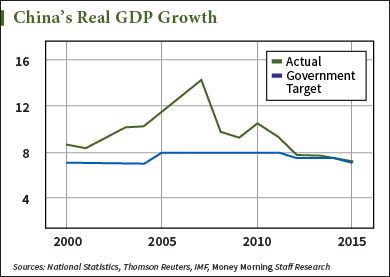Before this month's crash, Chinese markets doubled over seven months to peak at 5,166 in mid-June.
On the way up, anecdotes abounded of farmers abandoning their fields in favor of trading stocks on margin. By late June, there were more individual investors in China than the 87.8 million card-carrying members of the Communist Party of China.
Now, of course, the Shanghai Composite Index has crashed a staggering 28% since June 12. The boom isn't done going bust; there may still be more pain to come.
But the Chinese markets' spectacular crash obscures one of the most important market truths of the 21st century...
China is undergoing a massive transformation toward a consumer-driven economy – one that will see demand power surge to $67 trillion within a decade…
And one U.S. company has become the top choice to profit from this shift…
Stiff Headwinds Are No Match for China's Power
The recent Caixin Flash China General Manufacturing Purchasing Managers Index (PMI) reading at 48.2 disappointed the market, which expected 49.8.
A reading below 50 is considered to be a contraction. The PMI is based on new orders, inventory levels, production, supplier deliveries, and the employment environment across manufacturing, construction, retail, and service sectors.
 Forecasts for economic growth in China, according to a late July Reuters analyst poll, called for a 7% expansion this year and 6.7% next.
Forecasts for economic growth in China, according to a late July Reuters analyst poll, called for a 7% expansion this year and 6.7% next.
That's down considerably from the heady days of 10% and even 14%, which honestly shouldn't come as a complete surprise.
As an economy gets bigger, sustaining high-percentage growth rates becomes more challenging.
But what many China watchers forget is that a 7% rate of GDP growth this year would produce more output than 14% did just 8 years ago.
That's because - as I highlighted for you back in November - China has overtaken the United States as the world's largest economy. China's GDP is $17.6 trillion, versus America's at $17.4 trillion, on the basis of purchasing power parity.
Thanks in part to this milestone, some believe China's economy is one that's transitioning from a manufacturing/export base to a consumer one.
And the current Chinese government is certainly doing its part to help steer it in that direction...
China's Crucial Transformation Has Already Started
With an initiative towards improving production efficiency called "Made in China 2025," the government is implementing a strategy to shift the mentality from quantity to quality.
There's even the "Internet Plus" effort, which attempts to lift efficiency in areas like automotive, electronics, and distribution through the use of digital technology.
Still, some multinationals whose success relies considerably on China are complaining.
They tend to be clustered in the infrastructure segment, where companies like United Technologies Corp. (NYSE: UTX) and Caterpillar Inc. (NYSE: CAT) recently reported weaker Q2 earnings and outlook, citing softer Chinese demand.
But consumer-oriented players like Apple Inc. (Nasdaq: AAPL) and General Motors Co. (NYSE: GM) have a decidedly rosier stance.
The Demand Institute, a think tank jointly run by The Conference Board and Nielsen, issued the forecast stating the demand power of China’s consumer economy could reach an astonishing $67 trillion within a decade.
Frankly, that may not be unrealistic...
According to the UN, urbanization in developed countries averages about 90%. China is currently at 54%.
The United States currently has 750 cars per 1,000 people. By contrast, China has only 100 per 1,000.
Research firm ANZ Greater China reports that within just the next 15 years, China will have 326 million newly minted middle class members - more than the United States' entire current population.
That will catapult the economy from a current rate of 36% consumption to 50% consumption by 2030.
In the process, demand for all things consumer-related will keep charging higher. It's no secret the Chinese love their tech, and above all they love Apple Inc. (Nasdaq: AAPL).
Why Apple Is the Best China Growth Play
Apple, of course, needs no introduction.
[epom key="ddec3ef33420ef7c9964a4695c349764" redirect="" sourceid="" imported="false"]
But here's the case why buying Apple as a play on China's evolution towards a consumer economy makes perfect sense...
On a sales basis, Apple has over 50% of the world mobile phone market and roughly 30% of the personal computer/tablet market.
In the past year, the company recorded sales surpassing $224 billion - its best 12-month results ever.
Those sales contributed to $70 billion in free cash flow as well as $50 billion in earnings, up a staggering 39% from 2014 annual results.
And yet in late July, after Apple's latest earnings release, the stock dropped 7% mainly because iPhone sales didn't quite match forecasts. Analysts expected a lofty 48.4 million units, but sales were slightly under at 47.5 million, although still 35% higher than a year ago!
Even Mac sales were up 9% to 4.8 million units, contrasted with global PC sales that declined 12%.
Apple bought back $4 billion of its own stock and launched a $6 billion accelerated share repurchase plan into November.
But it's the China angle that, once again, is so relevant to Apple.
iPhone sales jumped 87% in China, versus market growth of just 5% in the country.
China's where Apple is getting the bulk of its growth. Last quarter, sales there were up 112% year over year, while profit soared 147%. That translated into 50% revenue growth accompanied by a 61% increase in income for the current fiscal year.
Meanwhile, AAPL shares remain cheap, trading at a P/E of 14 and just 3 times sales. Operating margins are 30% and profit at 22.6%. The $700 billion behemoth yields a nifty 1.7% dividend.
As China's unstoppable transition accelerates from manufacturing to consumption, Apple will be a top choice to profit. And that makes the recent pullback in Apple look that much sweeter.


